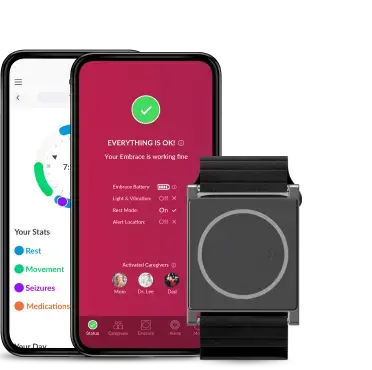What to do if someone has a seizure
You could be anywhere— on the metro, at work, or out dancing with friends, and someone could have a seizure. In fact, according to the Epilepsy Foundation, 1 in 26 people will develop epilepsy in their lifetime. Therefore, it's probably more likely than you initially imagined to observe someone having a seizure. How would you respond? Pure panic without any clue on how to help? Or, calm assurance because you know exactly what needs to be done? If you're a caregiver and it's your first time receiving an alert from Embrace, or if you're just a witness to the event, it can be scary and intimidating. But your role is important and can help the person from injuring themselves, and possibly even save their life.
Spreading awareness about epilepsy is not just dispelling myths and dispensing facts and statistics about the condition. It's also teaching how to help, and what to do when someone is having a seizure.
To make sure you're prepared, here are some steps to follow when someone has a seizure, provided by the Centers for Disease Control (CDC).
For any type of seizure
• Stay with the person until the seizure ends and he or she is fully awake. After it ends, help the person sit in a safe place. Once they are alert and able to communicate, tell them what happened in very simple terms.
• Comfort the person and speak calmly.
• Check to see if the person is wearing a medical bracelet or other emergency information.
• Keep yourself and other people calm.
• Offer to call a taxi or another person to make sure the person gets home safely.
First aid for generalized tonic-clonic seizures
• Ease the person to the floor.
• Turn the person gently onto one side. This will help the person breathe.
• Clear the area around the person of anything hard or sharp. This can prevent injury.
• Put something soft and flat, like a folded jacket, under his or her head.
• Remove eyeglasses.
• Loosen ties or anything around the neck that may make it hard to breathe.
• Time the seizure. Call 911 if the seizure lasts longer than 5 minutes.
What not to do
• Do not hold the person down or try to stop his or her movements.
• Do not put anything in the person’s mouth. This can injure teeth or the jaw. A person having a seizure cannot swallow his or her tongue.
• Do not try to give mouth-to-mouth breaths (like CPR). People usually start breathing again on their own after a seizure.
• Do not offer the person water or food until he or she is fully alert.
Your help is crucial
We hope that you feel more confident about how to respond to someone having a seizure. Knowing how to respond to a seizure should be common knowledge, and not just limited to caregivers. We encourage you to share this article with your friends and family to spread the knowledge. Given how common epilepsy is, one day they could play a vital role in someone's life when they're least expecting it.
The whole reason we set out to create Embrace is to speed up assistance to anyone having a convulsive seizure. Timely help may significantly improve health outcomes. You could be the person that turns someone over who has their head buried in a pillow allowing them to finally breathe. Or, you could be the person that safely gets someone to lie down so they don't suffer an injury. Knowing what to do in someone's time of need is something that everyone should know- and very well. So when the time comes, there's no panic or fluster. Instead, it's replaced with the ability to stay in control with a clear head so the person having the seizure gets the help they deserve.
Words worth reading
We do not guarantee that EpiMonitor will detect every single seizure and deliver alerts accordingly. It is not meant to substitute your current seizure monitoring practices, but rather to serve as a supplement in expediting first-response time.



